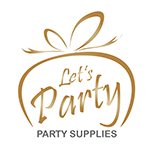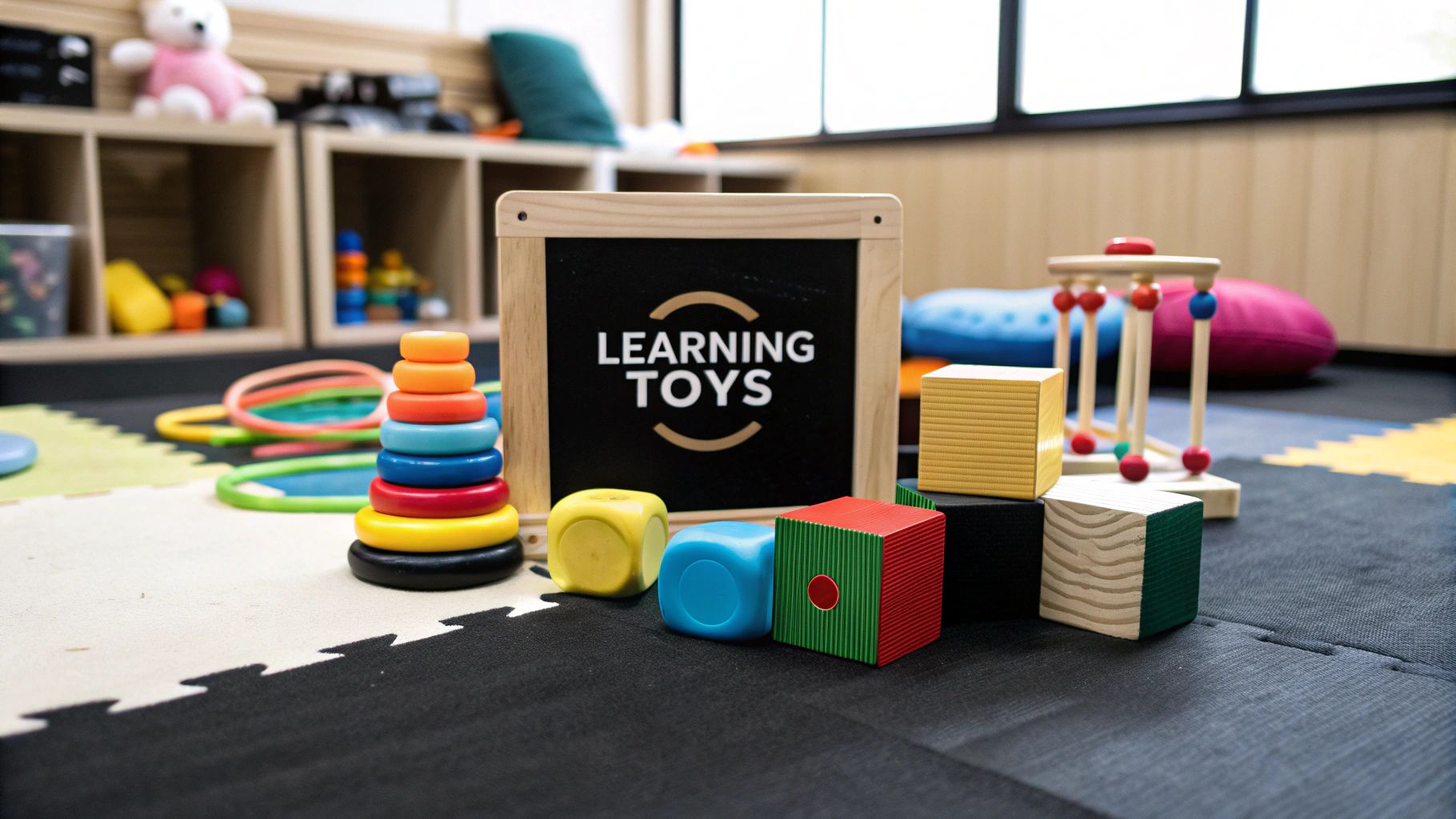
Welcome to the six-month mark! Your baby's world is suddenly bursting with possibilities, and this is the perfect time to introduce them to the magic of learning toys for 6 month olds. These aren't just for fun; they're the building blocks for huge developmental leaps in everything from motor skills to how they process the world around them. Think of this guide as your way to see playtime in a whole new light.
Your Baby’s World at Six Months
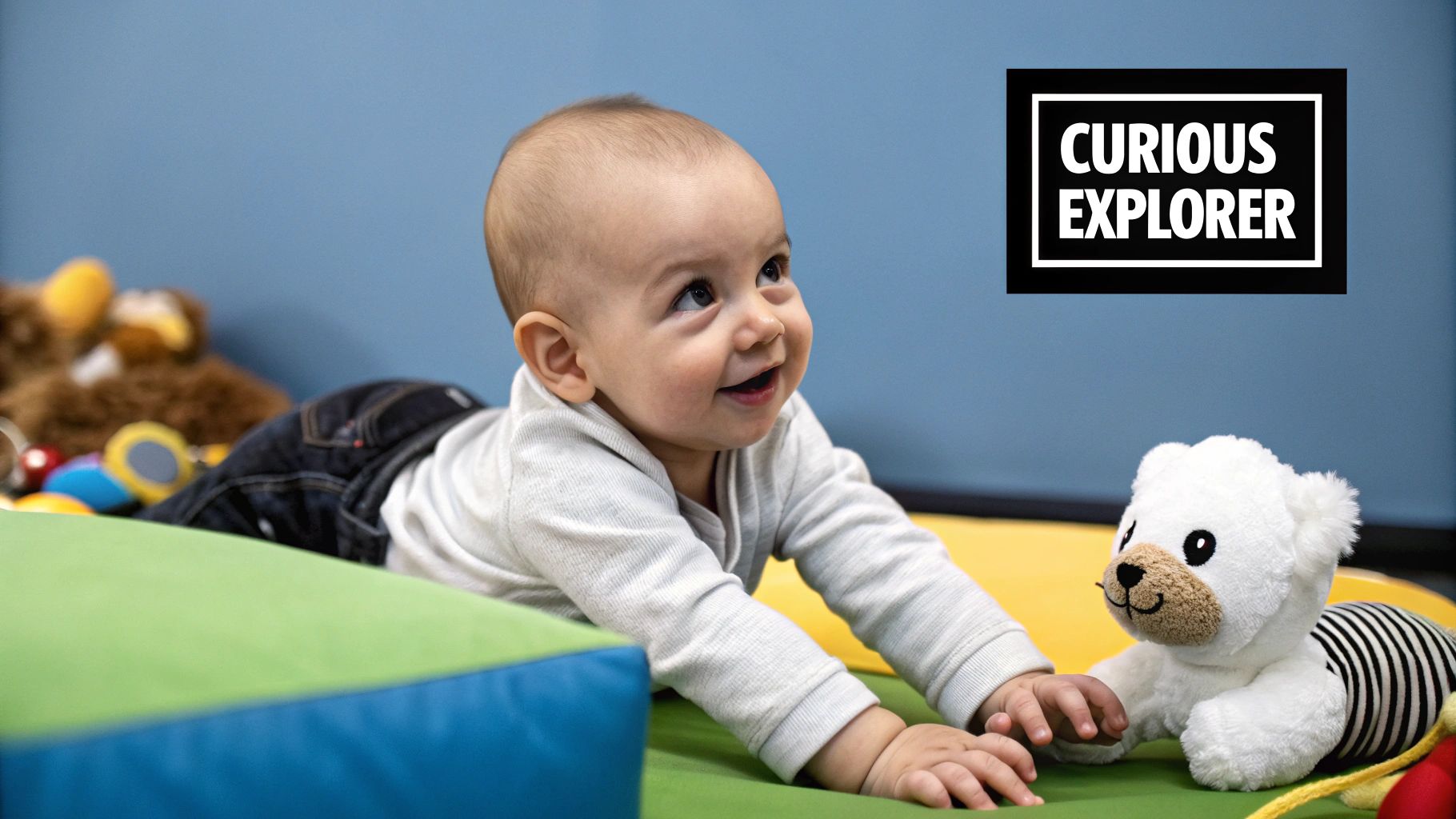
Picture your baby’s brain as a new computer, just starting up its most important programs. At six months old, that little computer is constantly running tests, trying to figure out how everything works. Every touch, sound, and sight is a new piece of data that helps form the foundation for all future learning. It’s a magical stage where they’re shifting from a tiny newborn into a hands-on, curious explorer.
The right toys are like the perfect software for this incredible little machine. They're much more than distractions; they're interactive programs teaching the most basic rules of the universe. That simple rattle? It’s a baby’s first lesson in cause and effect. A soft, textured ball isn’t just a colorful sphere—it’s a sensory deep-dive that helps their brain understand different feelings and surfaces.
From Observer to Active Participant
Around the half-year mark, you’ll see a major change. Babies are no longer just watching the world go by; they're becoming active players in it. This new sense of control is thrilling for them, and they’re hungry to try out their growing skills.
Here are a few key changes you're likely noticing:
- Purposeful Grasping: The random batting is gone. Now, they can intentionally reach out, grab a toy, and hold on tight.
- Oral Exploration: Everything goes straight into the mouth! This is one of their primary methods for learning about an object's texture, shape, and even its weight.
- Improved Core Strength: Many babies are learning to sit up with a little help, which gives them a brand-new vantage point on their surroundings.
- Early Communication: You'll hear more complex babbling and cooing as they start experimenting with all the sounds they can make.
At this age, play isn't just a pastime—it's your baby's most important work. Every single interaction with a toy builds new neural pathways, laying the groundwork for more advanced skills down the road.
Why the Right Toys Matter Now
Picking the best learning toys for your 6-month-old is all about matching them to these specific developmental milestones. A toy that’s too simple won't keep their attention for long, but one that’s too advanced will only lead to frustration. The goal is to find that perfect sweet spot where a toy is engaging but also challenging enough to push them forward.
In this guide, we'll go beyond just listing popular toys. We'll get into the "why" behind each category, connecting them directly to the cognitive, motor, and sensory skills your baby is working so hard to master. Get ready to see playtime as the powerful, brain-building activity it truly is.
Understanding Key Developmental Milestones
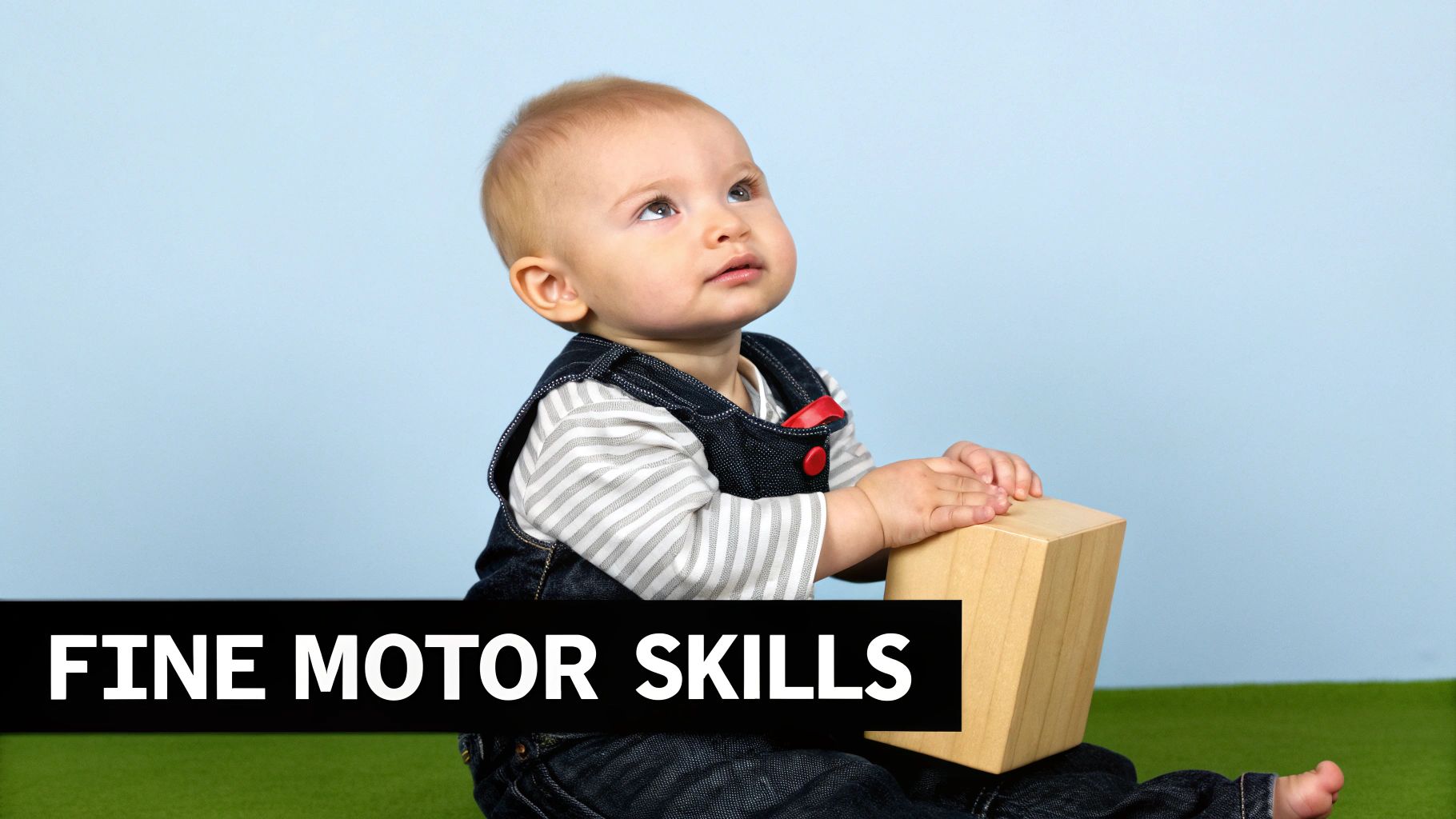
To pick out the perfect learning toys for your baby, you first have to appreciate the incredible job they're working on—growing! At six months old, your little one is smack in the middle of some massive developmental leaps. Just think of their brain as a super-absorbent sponge, soaking up every sight, sound, and feeling to figure out how this big, new world works.
Knowing what's happening behind the scenes is your secret weapon. It lets you choose learning toys for 6 month olds that are perfectly tuned to what they can do right now and what they're trying to master next. This simple shift turns playtime into a powerful experience that helps them build new skills with confidence and joy.
The Great Leap in Motor Skills
Probably the most obvious change you're seeing is how much they're moving! These motor skills are exploding with progress, and they generally fall into two key areas.
- Gross Motor Skills: This is all about the big muscles. Around the six-month mark, many babies are finally mastering the art of sitting up on their own, which completely changes their perspective on everything. That newfound core strength is the foundation for crawling, pulling up, and eventually walking.
- Fine Motor Skills: These are the smaller, more precise movements. You’ve probably noticed that the clumsy batting they used to do has been replaced by more purposeful reaching and grabbing. They’re even learning to pass a toy from one hand to the other—a surprisingly complex move that takes some serious coordination!
Toys that get them moving are a must. A wobbly toy placed just out of reach can be the perfect motivation to push up during tummy time, while lightweight blocks are great for practicing that hand-to-hand transfer.
Unlocking Cognitive Connections
It’s not just about physical growth. Your baby's brain is firing on all cylinders, making crucial connections that lay the groundwork for everything from problem-solving to language. The magic of cognitive development is happening faster than you can see.
One of the biggest ideas they’re starting to get is cause and effect. When they shake a rattle and it makes a noise, they're learning that their actions can create a reaction. It’s a game-changer, and it’s the foundation for how they'll interact with the world from now on.
Another huge milestone is the dawn of object permanence—the understanding that things still exist even when they disappear from view. Playing a simple game of peek-a-boo isn't just for giggles; it's a fun, interactive lesson that reinforces this huge cognitive leap.
Your baby is a tiny scientist conducting constant experiments. Every time they drop a toy, shake a rattle, or pull on a ribbon, they are collecting data and learning about the physical laws of their new world.
The Power of Sensory Exploration
At six months, a baby’s number one tool for investigation is their senses. Their hands and, yes, their mouths are how they gather the most information about an object. That's why everything they get their hands on goes straight for a taste test!
This is a totally normal—and vital—part of their development. They’re learning about different textures, shapes, and even temperatures. Giving them safe, clean toys made from a variety of materials, like soft fabric, chewy silicone, or smooth wood, is like feeding their brain with rich sensory data.
This focus on early development is a global trend. The infant and toddler toy market was recently valued at nearly USD 16.7 billion, with activity and developmental toys making up a huge piece of that pie. This shows just how many parents recognize the profound impact the right toys can have from the very beginning. You can explore more data about the growing infant toy industry to see how these trends are shaping what's available.
Babbling and Early Communication
Finally, don't underestimate the power of sound. Your baby’s coos and gurgles are getting more complex, forming the first tiny building blocks of language. They are listening intently to every word you say, learning about tone, rhythm, and emotion.
Toys that make gentle sounds—like a crinkly page in a soft book or a soft bell inside a ball—can grab their attention and encourage them to make their own sounds back. This little "conversation" is a crucial first step on their communication journey. Once you see all these milestones in action, you can confidently choose toys that are not just fun but truly developmental.
A Practical Guide to Toy Safety
When you’re looking for learning toys for 6 month olds, nothing is more important than safety. With so many options out there, knowing what to look for can feel like a huge task, but it doesn’t have to be. Think of safety standards not as boring legal jargon, but as a promise from the toy maker that they’ve put that product through its paces for your baby.
These guidelines are there to make sure every toy can handle the enthusiastic—and let's be honest, often rough—play of a curious infant. This focus on safety is a big reason why the educational toy market, valued at a staggering USD 66.22 billion, keeps growing. Parents trust toys that are built with safety in mind. You can read more about the growing market for educational toys on fortunebusinessinsights.com.
At the end of the day, you're your baby's best protector. A few quick checks at home can provide total peace of mind and turn your living room into a truly safe playground.
Decoding Safety Standards
You've probably seen labels on toy packaging that say something like "Meets ASTM F963 safety standards." So, what does that actually mean for you and your little one?
Think of ASTM F963 as the master rulebook for toy safety in the United States. It was created to prevent common injuries by setting very strict rules for everything from a toy's physical design to the chemicals used to make it. It’s not just a friendly suggestion; it’s a mandatory federal standard.
Here’s a simple breakdown of what it covers:
- Physical and Mechanical Tests: This makes sure toys are tough enough not to break into dangerous small parts or create sharp edges, even after being dropped or chewed on.
- Flammability Tests: This checks that a toy won’t easily catch fire if it comes near a flame.
- Chemical Safety: This is a big one. It limits the use of harmful stuff like lead and other heavy metals in paints, plastics, and other materials.
When you see that certification, it means the toy has passed a whole series of tests designed to anticipate exactly how a baby will play with it.
Your At-Home Safety Inspection
While official standards are great, nothing beats a quick, hands-on check before you give a new toy to your baby. Just run through this simple three-point inspection.
1. The Choke Hazard Test
This is, without a doubt, the most important safety check you can do. At six months old, babies explore everything with their mouths, which makes small objects a serious danger.
There’s an easy trick for this: the toilet paper roll test. If any toy, or any piece of a toy, can fit completely inside an empty toilet paper roll tube (which is about 1.25 inches wide), it's too small for your baby. This includes things that could potentially break off, like buttons on a doll, plastic eyes, or tiny wheels.
2. Check for Structural Integrity
Give the toy a good once-over. Run your hands along all the edges and surfaces.
- Are there any sharp points or rough edges that could scratch your baby's delicate skin?
- If it's a wooden toy, is the surface smooth and completely free of splinters?
- Are there any loose parts? Give any sewn-on bits or small plastic pieces a gentle tug to make sure they're secure.
Think of yourself as the toy's final quality control inspector. A toy should feel solid and well-made, with no questionable parts that look like they could pop off with a bit of determined pulling or chewing.
3. Material and Finish Scrutiny
What a toy is made of is just as important as how it’s built. Look for clear labels that tell you the materials are safe for infants.
- Non-Toxic Finishes: All paints and coatings should be clearly labeled as non-toxic.
- BPA-Free Plastics: If the toy is plastic, check that it’s marked as BPA-free, phthalate-free, and PVC-free.
- Fabric Quality: For plush or soft toys, look for strong, secure stitching to make sure the stuffing stays safely inside.
These simple steps only take a minute, but they are absolutely essential for creating a safe and fun play environment. Of course, toy safety is just one piece of the puzzle. Making sure the entire play area is safe is just as crucial, so be sure to check out our complete guide on how to childproof your home.
Choosing the Best Materials for Baby Toys
Once you’ve triple-checked that a toy is safe, the next thing to consider is what it’s made of. The material is everything—it determines a toy's texture, its weight, and even the sound it makes when dropped (or thrown!). For a six-month-old, who learns about the world almost entirely through their hands and mouth, the feel of a toy is just as important as its color or shape.
Think of your baby as a little scientist, and each new material is a new substance to investigate. The cool, solid feel of a wooden block teaches a completely different lesson than the soft, squishy feedback of a stuffed animal. By offering a variety of materials, you're essentially building their sensory library, helping their brain form a richer, more complex map of the world.
A Sensory Tour of Toy Materials
Every material offers a unique tactile experience. A well-rounded collection of learning toys for 6 month olds should include a mix of these textures to keep them curious and their sensory development firing on all cylinders.
- Classic Wood: Wooden toys are a classic for a reason. They're durable, timeless, and have a firm, satisfying texture. The clacking sound they make when knocked together is often a baby's first lesson in cause and effect. Just be sure to look for toys made from solid woods like maple or beech and finished with non-toxic, water-based paints so they're completely safe for mouthing.
- Soft Fabric: From crinkly books to plush animals, fabric toys are all about comfort and textural variety. They’re lightweight and easy for tiny hands to grab, squeeze, and wave around. Look for toys that incorporate different fabrics—like corduroy, satin, or fleece—to add even more layers to their sensory exploration.
- Food-Grade Silicone: This material is a total game-changer for baby toys. It’s soft and flexible, with a uniquely chewy texture that’s absolutely perfect for soothing sore gums during teething. Plus, silicone is incredibly durable, non-toxic, and a breeze to clean. A quick wash with soap and water is all it takes.
Knowing the sensory properties of each material helps you pick the right toy for the right moment. The infographic below connects these common materials to their main sensory benefits.
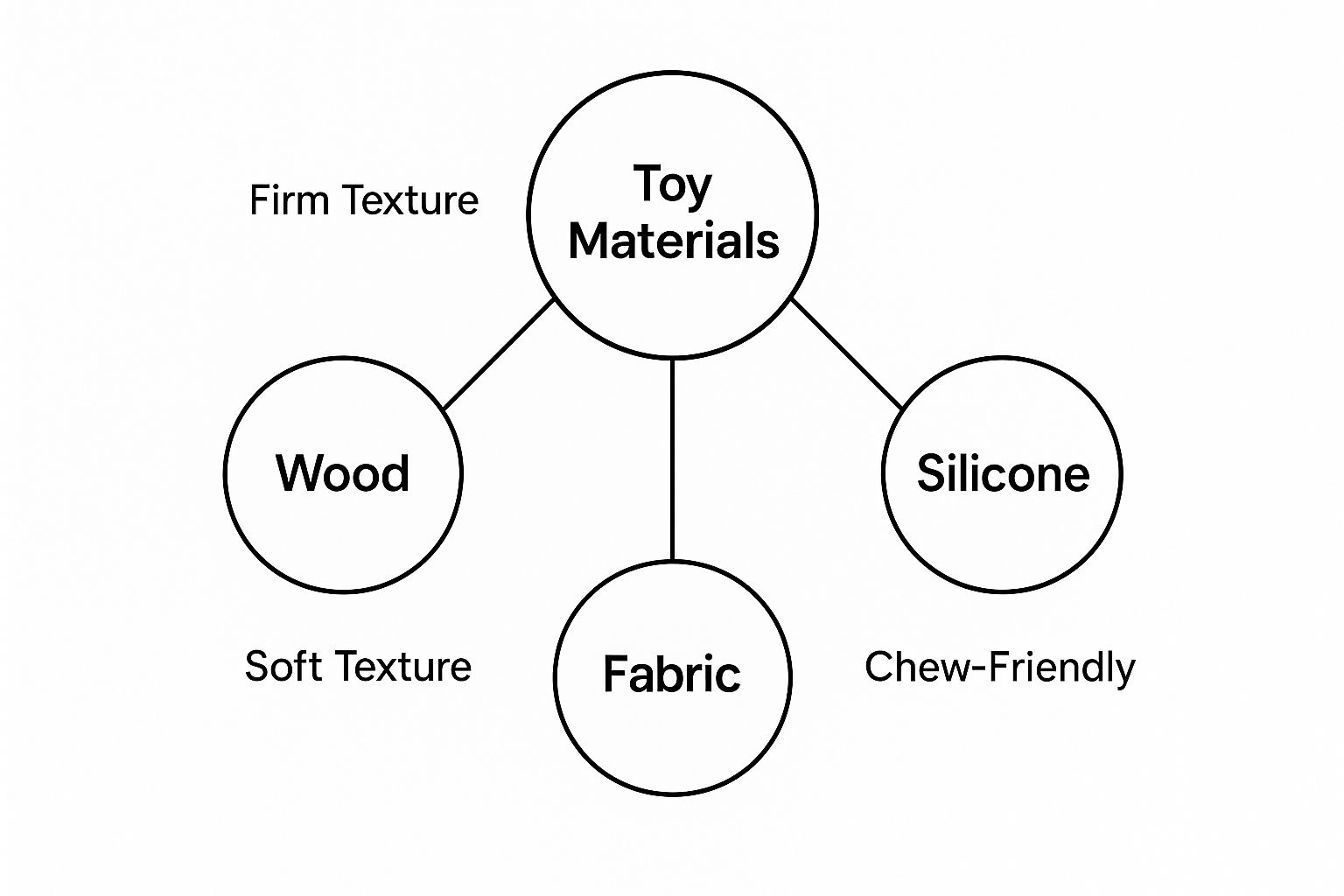
This visual guide is a handy reminder of how different materials provide unique tactile feedback—from the unyielding surface of wood to the pliable nature of silicone, which is a lifesaver during teething. For more on that, you can check out our guide on how to find the best teething toys for babies and our top picks.
Sustainability and Durability
The materials you choose also tell a bigger story. These days, there’s a welcome shift toward sustainability in the toy world, with parents and companies alike prioritizing eco-friendly options. This is a big deal in the baby toys market, which was valued at USD 15.67 billion and is seeing a major trend toward sustainable materials like natural wood and recycled plastics. Learn more about the baby toy market's growth and trends.
When you opt for toys made from FSC-certified wood, for instance, you're supporting responsibly managed forests. Choosing toys made from organic cotton or recycled materials helps reduce your environmental footprint while still giving your baby a safe, high-quality toy.
Finally, let’s talk about the practical side of things. Durability and how easy a toy is to clean are hugely important.
- Wood: Extremely durable but usually needs to be wiped down rather than soaked in water.
- Fabric: Durability can vary, so check if it’s machine washable for those inevitable messes.
- Silicone: Nearly indestructible and can often be sterilized or tossed right in the dishwasher.
- Safe Plastics (BPA-free): Generally very durable and simple to wipe clean.
Choosing the best materials really comes down to balancing sensory engagement with safety, sustainability, and practicality. A thoughtful mix will give your baby a rich, safe, and stimulating environment to explore.
Top Categories of Learning Toys for 6 Month Olds
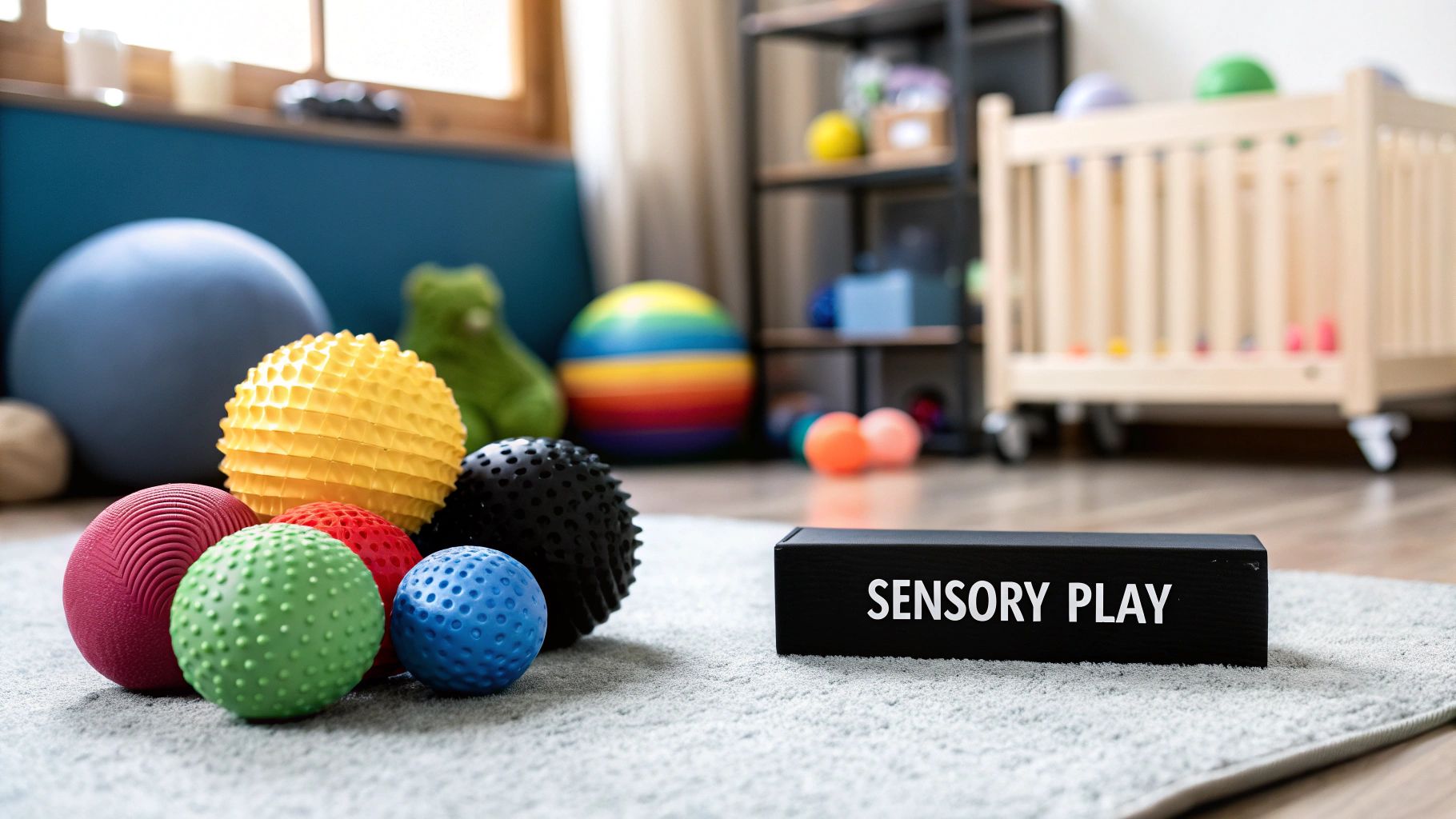
Alright, now that we've covered the amazing developmental leaps your baby is taking, let's get to the fun part: the toys! Choosing the right learning toys for 6 month olds isn't just about what's cute—it's about giving them the perfect tools for the job they're already hard at work on. Each type of toy targets specific skills, turning simple playtime into a powerful brain-building session.
This is where you can be smart about your choices. Instead of overwhelming your space (and your baby) with a mountain of plastic, you can build a small, thoughtful collection that covers all the key developmental bases. Think of it as creating a mini-gym for their growing mind and body.
H3: Sensory and Grasping Toys
At six months old, a baby’s hands and mouth are their primary instruments for exploring the world. Everything they can get their hands on will likely end up in their mouth for further investigation. That's why toys that cater to these senses are an absolute must.
Sensory toys are designed with different textures, sounds, and colors that wake up their developing senses.
- Sensory Balls: You've probably seen these—they’re often covered in soft spikes, bumps, or ridges. That texture is fantastic for their sense of touch, and they're usually lightweight enough for little hands to practice grasping and passing from one hand to the other.
- Crinkle Books: These soft fabric books are a triple threat. They have high-contrast images for visual stimulation, that irresistible crinkling sound for auditory feedback, and a soft texture that's perfect for grabbing and squishing.
- Teethers: More than just gum-soothers, teethers are designed for safe oral exploration. Made from materials like food-grade silicone, their varied textures help babies learn about different surfaces in a safe, controlled way.
These seemingly simple toys are powerhouses for developing fine motor skills. Every single time your baby grabs, holds, and inspects one, they are strengthening the tiny muscles in their hands and sharpening their hand-eye coordination.
The act of bringing a toy to their mouth is more than just teething relief. It’s a sophisticated form of sensory analysis where they use their highly sensitive tongue and lips to learn about an object's shape, hardness, and texture.
H3: Building Blocks and Stacking Toys
You might think blocks are for toddlers, but introducing them at six months lays some seriously important groundwork. Right now, it's not about building impressive towers; it’s all about exploration and cause-and-effect.
Soft blocks made from fabric or foam are the ideal starting point. They're light, easy to grip, and totally safe for chewing. Your baby will love grabbing them, waving them around, and—most excitingly—knocking over the small towers you build. That simple action is one of their first and most satisfying lessons in how the world works.
Later on, these same blocks will be there to help them learn more advanced skills like stacking and spatial reasoning. For a great overview of how different toys support your little one's learning journey, you can read our guide on the top educational toys for infants to boost learning: https://letsparty-au.myshopify.com/blogs/news/top-educational-toys-for-infants-to-boost-learning. And to see what's next on the horizon, check out this excellent guide on the best 10-month-old baby toys for development.
H3: Activity Centers and Cause-and-Effect Toys
Activity centers are like a whole world of discovery packed into one spot. These toys are specifically designed to teach that fundamental concept: "If I do this, that happens."
Look for interactive features that invite curiosity:
- Buttons that light up or make a sound when pushed.
- Spinners, beads, or rollers that your baby can bat at to make them move.
- Mirrors that let them see their own face and reactions.
These toys are also fantastic for helping babies practice sitting up, as they strengthen core muscles while keeping them happily occupied. They encourage short bursts of independent play, which is a win for everyone. Just be mindful of the time; these stationary entertainers should be used for around 15 minutes at a time to ensure your baby gets plenty of free floor time to roll, stretch, and prepare for crawling.
Matching Toys to Your Baby's Developing Skills
To make things a bit easier, here’s a quick-reference table that connects toy categories to the skills they support. Use it to help build a well-rounded toy box for your 6-month-old.
| Toy Category | Primary Skill Supported | Examples |
|---|---|---|
| Sensory & Grasping | Fine Motor Skills, Sensory Exploration | Textured balls, crinkle books, teethers |
| Building & Stacking | Hand-Eye Coordination, Cause & Effect | Soft fabric blocks, large plastic rings |
| Activity Centers | Cognitive Development, Gross Motor Skills | Stationary entertainers, play gyms |
By picking a few items from each category, you can feel confident that you’re not just providing entertainment, but also supporting every facet of their incredible development.
Your Go-To Toy Selection Checklist
Alright, let's pull all of this together. Choosing the right learning toys for your 6-month-old doesn't need to feel overwhelming. When you know what developmental stage they're in, you can pick toys that are not just fun, but genuinely helpful and safe.
Think of this as your quick-reference guide for when you're in the store or browsing online. It’s a simple filter to make sure every toy you bring home is a winner.
The Four Core Rules of Smart Toy Selection
Here’s a simple framework to run every potential toy through. If it ticks these four boxes, you can feel confident it's a great choice.
-
Safety is Non-Negotiable
This is the most important rule, period. Always check the packaging for safety certifications (like ASTM F963). Before you hand it over, do a quick "mom check"—no sharp edges, no loose parts, and nothing small enough to fit through a toilet paper roll. -
Match the Milestone
Pick toys that meet your baby where they are right now. We're talking about toys that make them want to grasp, reach, sit up, and figure out that "if I do this, that happens." A toy should be a fun challenge, not a source of frustration. -
Materials and Durability Count
Babies explore with their mouths, so non-toxic materials are a must. Look for things like food-grade silicone, solid wood with a non-toxic finish, or soft fabrics you can toss in the wash. A well-made toy will stand up to some serious drool and gumming. -
Go for Open-Ended Play
The best toys are the simple ones that can be used in a dozen different ways. Think stacking rings or basic blocks. These fire up a baby's creativity so much more than a single-button electronic toy and will keep their interest long past the 6-month mark.
The goal isn't to have a mountain of toys, but a small, curated collection of high-quality, purposeful items. It's truly about quality over quantity—making sure each toy helps nurture your baby's budding skills.
As you're figuring out what you need, creating a baby shower registry can be a huge help. It guides friends and family toward toys that are actually useful, helping you build a fantastic starter set of learning tools from day one.
Got Questions? We’ve Got Answers
Stepping into the world of baby toys can feel overwhelming. What do they really need? Are these safe? Is this one worth it? It’s completely normal to have questions. We’ve been there. So, we’ve put together some straightforward answers to the things parents most often ask about learning toys for 6 month olds.
How Many Toys Should My 6-Month-Old Have?
Honestly, less is more. It’s so easy for a baby to get overstimulated by a mountain of toys. Instead of piling them high, focus on a small, thoughtful collection of about 5 to 8 high-quality, age-appropriate toys.
The real trick is to offer variety, not volume. Aim to have one or two things that serve different purposes: a good teether for their gums, a sensory ball that’s easy to grab, some soft blocks for stacking and knocking down, and maybe a crinkle book to engage their eyes and ears. That way, you’re hitting all the key developmental notes without creating a ton of clutter.
What’s This “Toy Rotation” I Keep Hearing About?
Toy rotation is one of the best-kept secrets of experienced parents. It’s simple: you keep just a few toys out for your baby to play with and store the rest out of sight. Then, every week or so, you swap them out. It’s a game-changer for a few reasons.
- It keeps toys feeling new: When a toy reappears after a week away, it’s like a brand-new discovery for your baby.
- It cuts down on overstimulation: A tidy, uncluttered play area helps your baby focus and play more deeply with the toys they have.
- It sparks creativity: With fewer choices, babies get more inventive and really explore what each toy can do.
You don't need a fancy system. A simple storage bin will do the trick. It’s an easy way to get way more mileage out of the toys you already own.
Are Electronic Toys a Bad Idea for a 6-Month-Old?
This is a hot topic, and there isn't a hard "yes" or "no" answer. A lot of electronic toys are sold as being "educational," but they often encourage babies to be passive observers rather than active participants. At six months old, the best kind of play is hands-on, driven by their own curiosity.
The most powerful learning toys for this age are usually the simplest ones. Think about toys that require the baby to do something to make the fun happen, instead of just watching a pre-programmed light show. That’s how they start building real problem-solving skills.
If you do go for an electronic toy, pick one that responds directly to what your baby does. For example, a button that lights up or makes a sound right when they push it teaches a clear lesson about cause and effect. Still, try to make open-ended, non-electronic toys the foundation of their playtime.
How Often Do I Really Need to Clean These Toys?
With a 6-month-old, everything eventually goes into their mouth, so keeping toys clean is a top priority. For hard plastic or silicone toys, a quick wipe-down with a baby-safe, non-toxic cleaner every day is a great routine. You’ll want to give them a proper wash with soap and water a couple of times a week, especially if they’ve taken a trip to the floor.
Plush or fabric toys usually have a care label; if they’re machine washable, tossing them in on a gentle cycle once a week works wonders. For wooden toys, just wipe them with a damp cloth—soaking them in water can warp the wood. A little bit of a cleaning schedule goes a long way in keeping germs away and making sure their play space is safe and healthy.
At FindTopTrends, we curate the best products to support you and your family at every stage. Explore our collection to discover high-quality essentials that make life simpler and more enjoyable. Find your next favorite thing at https://findtoptrends.com.



